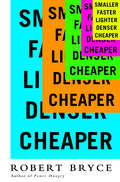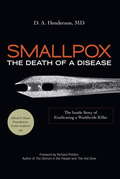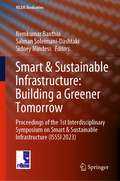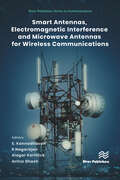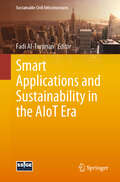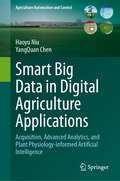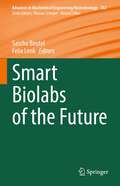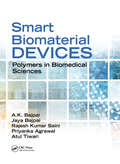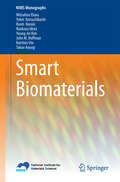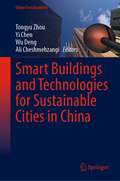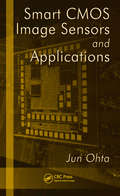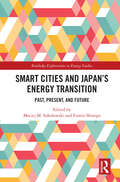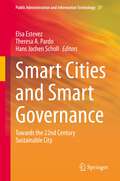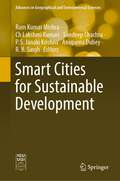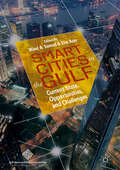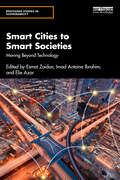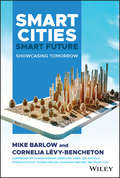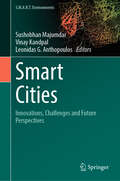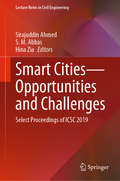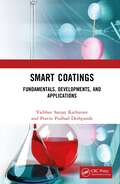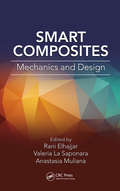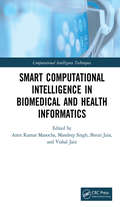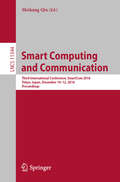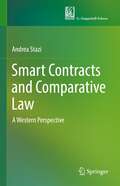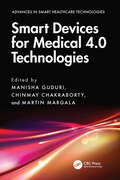- Table View
- List View
Smaller Faster Lighter Denser Cheaper: How Innovation Keeps Proving the Catastrophists Wrong
by Robert BryceIn the face of today's environmental and economic challenges, doomsayers preach that the only way to stave off disaster is for humans to reverse course: to de-industrialize, re-localize, ban the use of modern energy sources, and forswear prosperity. But in this provocative and optimistic rebuke to the catastrophists, Robert Bryce shows how innovation and the inexorable human desire to make things Smaller Faster Lighter Denser Cheaper is providing consumers with Cheaper and more abundant energy, Faster computing, Lighter vehicles, and myriad other goods. That same desire is fostering unprecedented prosperity, greater liberty, and yes, better environmental protection.Utilizing on-the-ground reporting from Ottawa to Panama City and Pittsburgh to Bakersfield, Bryce shows how we have, for centuries, been pushing for Smaller Faster solutions to our problems. From the vacuum tube, mass-produced fertilizer, and the printing press to mobile phones, nanotech, and advanced drill rigs, Bryce demonstrates how cutting-edge companies and breakthrough technologies have created a world in which people are living longer, freer, healthier, lives than at any time in human history.The push toward Smaller Faster Lighter Denser Cheaper is happening across multiple sectors. Bryce profiles innovative individuals and companies, from long-established ones like Ford and Intel to upstarts like Aquion Energy and Khan Academy. And he zeroes in on the energy industry, proving that the future belongs to the high power density sources that can provide the enormous quantities of energy the world demands.The tools we need to save the planet aren't to be found in the technologies or lifestyles of the past. Nor must we sacrifice prosperity and human progress to ensure our survival. The catastrophists have been wrong since the days of Thomas Malthus. This is the time to embrace the innovators and businesses all over the world who are making things Smaller Faster Lighter Denser Cheaper.
Smallpox: The Death of a Disease
by D. A. HendersonFor more than 3000 years, hundreds of millions of people have died or been left permanently scarred or blind by the relentless, incurable disease called smallpox. In 1967, Dr. D.A. Henderson became director of a worldwide campaign to eliminate this disease from the face of the earth.This spellbinding book is Dr. Henderson's personal story of how he led the World Health Organization's campaign to eradicate smallpox--the only disease in history to have been deliberately eliminated. Some have called this feat "the greatest scientific and humanitarian achievement of the past century."In a lively, engrossing narrative, Dr. Henderson makes it clear that the gargantuan international effort involved more than straightforward mass vaccination. He and his staff had to cope with civil wars, floods, impassable roads, and refugees as well as formidable bureaucratic and cultural obstacles, shortages of local health personnel and meager budgets. Countries across the world joined in the effort; the United States and the Soviet Union worked together through the darkest cold war days; and professionals from more than 70 nations served as WHO field staff. On October 26, 1976, the last case of smallpox occurred. The disease that annually had killed two million people or more had been vanquished-and in just over ten years.The story did not end there. Dr. Henderson recounts in vivid detail the continuing struggle over whether to destroy the remaining virus in the two laboratories still that held it. Then came the startling discovery that the Soviet Union had been experimenting with smallpox virus as a biological weapon and producing it in large quantities. The threat of its possible use by a rogue nation or a terrorist has had to be taken seriously and Dr. Henderson has been a central figure in plans for coping with it.New methods for mass smallpox vaccination were so successful that he sought to expand the program of smallpox immunization to include polio, measles, whooping cough, diphtheria, and tetanus vaccines. That program now reaches more than four out of five children in the world and is eradicating poliomyelitis.This unique book is to be treasured--a personal and true story that proves that through cooperation and perseverance the most daunting of obstacles can be overcome.
Smart & Sustainable Infrastructure: Proceedings of the 1st Interdisciplinary Symposium on Smart & Sustainable Infrastructure (ISSSI 2023) (RILEM Bookseries #48)
by Sidney Mindess Nemkumar Banthia Salman Soleimani-DashtakiThis book gathers peer-reviewed contributions presented at the 1st Interdisciplinary Symposium on Smart & Sustainable Infrastructure (ISSSI), held in Vancouver, BC, Canada, on September 4–8, 2023, and affiliated with the 77th RILEM Annual Week 2023. Aiming at creating an environment of mutual cooperation between experts in materials and structures, it covers topics such as sensors, IoT, and structural health monitoring, AI and machine learning, data analytics for infrastructure management, nanotechnology, additive manufacturing, smart and bioinspired materials, durability of materials and structures, resilience to earthquakes, floods, fire and blast, carbon reduction in construction and operations, and sustainable ultra-high performance materials. The contributions, which were selected through a rigorous international peer-review process, share exciting ideas that will spur novel research directions and foster new multidisciplinary collaborations.
Smart Antennas, Electromagnetic Interference and Microwave Antennas for Wireless Communications
by R. Nagarajan S. Kannadhasan Alagar Karthick Aritra GhoshThis book covers all areas of smart antennas, electromagnetic interference, and microwave antennas for wireless communications. Smart antennas or adaptive antennas are multi-antenna components on one or both sides of a radio communication connection, combined with advanced signal processing algorithms. They've evolved into a critical technology for third-generation and beyond mobile communication systems to meet their lofty capacity and performance targets. It seems that a significant capacity gain is achievable, particularly if they are employed on both sides of the connection. There are several essential characteristics of these systems that need scientific and technical investigation. Included in the book are beamforming, massive MIMO, network MIMO, mmwave transmission, compressive sensing, MIMO radar, sensor networks, vehicle-to-vehicle communication, location, and machine learning.
Smart Applications and Sustainability in the AIoT Era (Sustainable Civil Infrastructures)
by Fadi Al-TurjmanThis book gathers recent research work on emerging Artificial Intelligence (AI) methods for processing and storing data generated by smart infrastructures. Smart infrastructures gather Terabytes of data nowadays with no need for traditional control. The data automatically uploads to the cloud computing platform. The cloud analyses the data and generates the required output in visualization, graph, and action. A remote access network can be constructed dependent on either low-elevation or high-altitude stages. When associated with satellite and earthly frameworks, these stages empower a far-reaching access network with worldwide inclusion and diverse administration provisioning. Data analytics are used in agriculture, mining, waste management, energy, and military defenses. Major topics covered include the analysis and development of AI-powered mechanisms in future IoT and smart infrastructures applications. Further, the book addresses new technological developments, current research trends, and industry needs. Presenting case studies, experience and evaluation reports, and best practices in utilizing AI applications in IoT networks, it strikes a good balance between theoretical and practical issues. It also provides technical/scientific information on various aspects of AI technologies, ranging from basic concepts to research grade material, including future directions. The book is intended for researchers, practitioners, engineers and scientists involved in the design and development of protocols and AI applications for smart and sustainable infrastructure-related devices.
Smart Big Data in Digital Agriculture Applications: Acquisition, Advanced Analytics, and Plant Physiology-informed Artificial Intelligence (Agriculture Automation and Control)
by YangQuan Chen Haoyu NiuIn the dynamic realm of digital agriculture, the integration of big data acquisition platforms has sparked both curiosity and enthusiasm among researchers and agricultural practitioners. This book embarks on a journey to explore the intersection of artificial intelligence and agriculture, focusing on small-unmanned aerial vehicles (UAVs), unmanned ground vehicles (UGVs), edge-AI sensors and the profound impact they have on digital agriculture, particularly in the context of heterogeneous crops, such as walnuts, pomegranates, cotton, etc. For example, lightweight sensors mounted on UAVs, including multispectral and thermal infrared cameras, serve as invaluable tools for capturing high-resolution images. Their enhanced temporal and spatial resolutions, coupled with cost effectiveness and near-real-time data acquisition, position UAVs as an optimal platform for mapping and monitoring crop variability in vast expanses. This combination of data acquisition platforms and advanced analytics generates substantial datasets, necessitating a deep understanding of fractional-order thinking, which is imperative due to the inherent “complexity” and consequent variability within the agricultural process. Much optimism is vested in the field of artificial intelligence, such as machine learning (ML) and computer vision (CV), where the efficient utilization of big data to make it “smart” is of paramount importance in agricultural research. Central to this learning process lies the intricate relationship between plant physiology and optimization methods. The key to the learning process is the plant physiology and optimization method. Crafting an efficient optimization method raises three pivotal questions: 1.) What represents the best approach to optimization? 2.) How can we achieve a more optimal optimization? 3.) Is it possible to demand “more optimal machine learning,” exemplified by deep learning, while minimizing the need for extensive labeled data for digital agriculture? This book details the foundations of the plant physiology-informed machine learning (PPIML) and the principle of tail matching (POTM) framework. It is the 9th title of the "Agriculture Automation and Control" book series published by Springer.
Smart Biolabs of the Future (Advances in Biochemical Engineering/Biotechnology #182)
by Sascha Beutel Felix LenkThis book reviews the advances in data gathering and processing in the biotech laboratory environment, and it sheds new lights on the various aspects that are necessary for the implementation of intelligent laboratory architecture and infrastructure. Smart technologies are increasingly dominating our everyday lives and have become an indispensable part of the industrial environment. The laboratory environment, which has long been rather conservative, has also set out to adapt smart technologies with regards to Industry 4.0 and the Internet of Things (IoT) for the laboratory. Due to the heterogeneity of the existing infrastructure and the often complex work processes, standardization is slow, e.g. to implement device interfaces or standardized driver protocols, which are urgently needed to generate standardized data streams that would be immanent for post-processing of data.Divided into 9 chapters, this book offers an authoritative overview of the diverse aspects in the generation and recording of uniform data sets in the laboratory, and in the processing of the data and enabling seamless processing towards machine learning and artificial intelligence. In the first part of the book, readers will find more about high throughout systems, automation, robotics, and the evolution of technology in the laboratory. The second part of the book is devoted to standardization in lab automation, in which readers will learn more about some regulatory aspects, the SiLA2 standards, the OPC LADS (Laboratory and Analytical Device Standard), and FAIR Data infrastructure
Smart Biomaterial Devices: Polymers in Biomedical Sciences
by Atul Tiwari A.K. Bajpai Jaya Bajpai Rajesh Kumar Saini Priyanka AgrawalPolymers have emerged as one of the most innovative classes of materials in modern materials science, leading to new applications in medicine and pharmacy. This book offers a convincing and understandable approach to polymer biomaterial devices being used in various areas related to biomedical and pharmaceutical fields. The polymer materials finding application as biomaterials are discussed and described in detail pertaining to the areas of artificial implants, orthopedics, ocular devices, dental implants, drug delivery systems, burns and wounds.
Smart Biomaterials
by Ravin Narain Mitsuhiro Ebara Yohei Kotsuchibashi Naokazu Idota Young-Jin Kim John M. Hoffman Koichiro Uto Takao AoyagiThis book provides comprehensive coverage of smart biomaterials and their potential applications, a field that is developing at a very rapid pace. Because smart biomaterials are an emerging class of biomaterials that respond to small changes in external stimuli with large discontinuous changes in their physical properties, they have been designed to act as an "on-off" switch for, among others, bio separation, immunoanalysis, drug delivery technologies, gene therapy, diagnostics, bio sensors and artificial muscles. After an introduction to the topic and the history of smart biomaterials, the author gives the reader an in-depth look at the properties, mechanics, and characterization of smart biomaterials including hydrogels, particles, assemblies, surfaces, fibers and conjugates. Information on the wide range of applications for these materials follows, including drug delivery, tissue engineering, diagnostics, biosensors, bio separation and actuators. In addition, recent advances in shape memory biomaterials as active components of medical devices are also presented.
Smart Buildings and Technologies for Sustainable Cities in China (Urban Sustainability)
by Ali Cheshmehzangi Wu Deng Yi Chen Tongyu ZhouThis book brings together the insights from professional associations who involved in developing relevant national standards in China, domestic and international scholars who are dedicated to research in related fields, and industry practitioners who have the most hands-on experience. Synthesizing their perspectives, this book discusses the advanced technologies that can meet the requirements for energy efficiency, building performance monitoring and management, and user-centric building services, which are considered the essential components for achieving sustainable and smart cities. Moreover, it provides reflections on the implementation of smart technologies and strategies in practice.
Smart CMOS Image Sensors and Applications (Optical Science and Engineering #Vol. 129)
by Jun OhtaBecause of their high noise immunity and low static power supply drain, complementary metal-oxide-semiconductor (CMOS) devices produce less heat than other forms of logic and allow a high density of logic functions on a chip. These beneficial characteristics have fueled the use of CMOS image sensors in consumer electronics, robot vision, biotechnology, and medicine. With the introduction of smart functions in CMOS image sensors, even more versatile applications are now possible.Exploring this popular technology, Smart CMOS Image Sensors and Applications focuses on the smart functions implemented in CMOS image sensors as well as the applications of these sensors. After discussing the history of smart CMOS image sensors, the book describes the fundamental elements of CMOS image sensors. It covers some optoelectronic device physics and introduces typical CMOS image sensor structures, such as an active pixel sensor (APS). Subsequent chapters elucidate the functions and materials of smart CMOS image sensors and present examples of smart imaging. The final chapter explores various applications of smart CMOS image sensors. Several appendices supply a range of information on constants, illuminance, MOSFET characteristics, and optical resolution.This book provides a firm foundation in existing smart CMOS image sensor technology and applications, preparing you for the next phase of smart CMOS image sensors.
Smart Cities and Japan's Energy Transition: Past, Present, and Future (Routledge Explorations in Energy Studies)
by Maciej M. Sokołowski Fumio ShimpoThis book offers a complex and problem-based analysis of the past, present, and future of smart cities in Japan’s energy transition.With 92% of Japanese living in urban areas and a goal of achieving net-zero greenhouse gas emissions by 2050, Japan’s energy future will depend largely on how its cities can become smarter, greener, and more resilient. To reach these ambitions, a collective effort is required, with actions coming from Tokyo to Kumamoto, from Yokohama to Sapporo, and throughout dozens of smaller and bigger Japanese urban structures. This book addresses the key issues that have emerged or may emerge in various Japanese cities that are pursuing smart energy initiatives. The authors examine several issues, including international cooperation, heating decarbonisation, foreign direct investments, city planning, housing policies, and technology-related risks in the context of Japan’s energy transition.Drawing on case studies from different regions of Japan and sectors of Japanese economy significant for reaching carbon neutrality, this book will be a valuable resource for all interested in energy transition, climate action, and smart cities, where Japan and Japanese smart cities serve as excellent benchmarks.
Smart Cities and Smart Governance: Towards the 22nd Century Sustainable City (Public Administration and Information Technology #37)
by Theresa A. Pardo Hans Jochen Scholl Elsa EstevezThis edited volume discusses smart cities and smart governance within the framework of the 22nd century sustainable city. Written by members of the Smart Cities Smart Government Research Practice Consortium (SCSGRPC), an international multidisciplinary consortium of researchers and practitioners devoted to studying smart governance, this book provides a foundation for global efforts to envision and prepare for the next generation city by advancing understanding of the nature of and need for novel policies, new administrative practices, and enabling technologies required to advance urban governance, governments, and infrastructure. The chapters focus on practical models and approaches, theoretical frameworks, policy models, emerging issues, questions and research problems, as well as including case studies from different parts of the world. A valuable addition to the body of knowledge on smartness in urban government, this book will be of use to researchers in the fields of public administration, political science, information science, and information systems, as well as policy makers and government officials working on implementing smart technology in their cities.
Smart Cities for Sustainable Development (Advances in Geographical and Environmental Sciences)
by Ram Kumar Mishra R. B. Singh Anupama Dubey Ch Lakshmi Kumari Sandeep Chachra P. S. Janaki KrishnaThis book reviews the structure, applications, technologies, governance, environmental sustainability, smart communities, gender space and other issues related to smart cities. The book is divided into four parts. The first one entails the conceptual background, growth and development. The second part presents diverse issues on smart cities in terms of environmental sustainability, the role of the community, and gender space, among others. The third part revolves around economic and technological issues, and the fourth is a compilation of case studies in connection with smart cities. This collection of diverse issues from different locations presents a holistic view of smart cities contributed by authors who have undertaken research projects and implemented their own unique perspectives and methods. A variety of innovative concepts such as digital governance, polycentric structures, geodata repositories, geoweb services and advanced geospatial technologies in smart city planning, urban microclimatic parameters, and urban heat islands provide invaluable knowledge for researchers and practitioners in these fields.
Smart Cities in the Gulf: Current State, Opportunities, And Challenges
by Wael A. Samad Elie AzarIn this edited volume, academics and practitioners from various disciplines investigate the challenges, opportunities and frameworks in the implementation of Smart Cities in the Gulf.The volume presents insightful analyses and identifies key lessons learned through case studies covering four main themes including smart city frameworks and governance, resources and infrastructure, information and communication technologies, and the social perspective. In doing so, the book provides policy recommendations related to smart governance, as well as overall frameworks that cities can adopt in their process of transition, and knowledge that is integral to bridge the gap between various stakeholders in the Smart City milieu. This edited volume comprises extended versions of papers presented at a workshop held at the University of Cambridge, UK titled “Smart Cities in the GCC: Current State, Opportunities and Challenges.”
Smart Cities to Smart Societies: Moving Beyond Technology (Routledge Studies in Sustainability)
by Elie Azar Imad Antoine Ibrahim Esmat ZaidanThis book explores the governance of smart cities from a holistic approach, arguing that the creation of smart cities must consider the specific circumstances of each country to improve the preservation, revitalisation, liveability, and sustainability of urban areas. The recent push for smart cities is part of an effort to reshape urban development through megaprojects, centralised master planning, and approaches that convey modernism and global affluence. However, moving towards a citywide smart transition is a major undertaking, and complexities are expected to grow exponentially. This book argues that a comprehensive approach is necessary to consider all relevant aspects. The chapters seek to identify the potential and pitfalls of the smart transformation of urban communities and its role in sustainability goals; share state-of-the-art practices concerning technology, policy, and social science dimensions in smart cities and communities; and develop opportunities for cooperation and partnership in wider and larger research and development programmes. Divided into three parts, the first part of the book highlights the significance of various societal elements and factors in facilitating a successful smart transition, with a particular emphasis on the role of human capital. The second part delves into the challenges associated with technology and its integration into smart city initiatives. The final part of the book examines the current state of regulations and policies governing smart cities. The book will be an important asset for students and researchers studying law, engineering, political science, international relations, geopolitics, economics, and engineering.
Smart Cities, Smart Future: Showcasing Tomorrow
by Mike Barlow Cornelia Levy-BenchetonAre you curious about smart cities? You should be! By mid-century, two-thirds of us will live in cities. The world of tomorrow will be a world of cities. But will they be smart cities? Smart cities are complex blends of technologies, systems and services designed and orchestrated to help people lead productive, fulfilling, safe and happy lives. This remarkable book is a window into our shared future. In crisp language and sharp detail, Mike Barlow and Cornelia Lévy-Bencheton explain how smart cities are powerful forces for positive change. With keen eyes and warm hearts, they invite readers to imagine the world of tomorrow, a fascinating world of connected cities and communities. They capture and convey the depth and richness of the worldwide smart city movement. Smart Cities, Smart Future describes the impact of smart city projects on people in towns, cities and nations around the world. The book includes descriptions of ongoing smart city projects in North America, Europe, Asia and the Middle East. Looking Ahead to an Urban World No two smart cities are alike. No one can say with certainty or precision what the term “smart city” means. There is no standard definition or common template. Today, smart cities are works in progress. They emerge from our hopes and our dreams. This book provides you with the knowledge and insight you need to participate in the smart city movement. It explains how smart cities are “systems of systems” and introduces key concepts such as interoperability, open standards, resiliency, agility, adaptability and continuous improvement. Includes Detailed Glossary of Terms and Essential Vocabulary The book includes a detailed comprehensive glossary of essential smart city terms. The glossary will become your indispensable resource as you engage more deeply with the smart city movement and become more involved in planning our common future in an urban world. Carefully Researched and Crisply Written Smart Cities, Smart Future is carefully researched and fully documented. It includes interviews with leaders and experts in multiple disciplines essential to the development of smart cities, towns, regions, states and nations. Written in the clean style of modern journalism, the book offers a strong and compelling narrative of a changing world. It reminds us that we are responsible for choosing our destiny and determining the shape of things to come. The smart city movement is gaining speed and momentum. Read this book, and enjoy the ride!
Smart Cities: Innovations, Challenges and Future Perspectives (S.M.A.R.T. Environments)
by Leonidas G. Anthopoulos Sushobhan Majumdar Vinay KandpalThis book aims to integrate new technologies and adaptation tools into the process of smart city planning. It also emphasizes the value and importance of modern technologies such as IoT and data science as a smart technology for the formation of a smart city. The authors believe that various technologies in a smart city will reduce all the problems for the sustainable growth and future prospects of the city. The first section of this book discusses the innovation of new technologies (AI, data science, block chain, etc.) that has flourished in recent decades which will make the city smarter. This section also describes that block chain and IoT (Internet of Things) are two transformative technologies that can greatly impact smart cities by enhancing security, improving transparency, and enabling efficient management of resources. The second section of the book explains about the uses of AI tools and smart technologies (like waste management, public safety and security) for the development and management of smart cities. This chapter also describes AI-powered systems that are integrated into smart buildings to optimize energy usage, enhance occupant comfort, and improve building management. These systems can adjust lighting and HVAC settings based on occupancy, learn user preferences, and provide personalized energy efficiency recommendations. The third portion of the book investigates the recent challenges and barriers of smart city that have been faced by the smart cities in the recent decades. This section also describes various challenges and barriers for the implementation of IoT sensor, AI technologies, etc., for the formation of a smart city. The future prospects of a smart city are the main theme of the last chapter. In this section, an attempt has been made about the future vision and outlook of the smart city. This chapter also describes different approaches (like smart grid, societal smart city, smart city model, etc.) for the future planning and management of the city.
Smart Cities—Opportunities and Challenges: Select Proceedings of ICSC 2019 (Lecture Notes in Civil Engineering #58)
by Sirajuddin Ahmed S. M. Abbas Hina ZiaThis book comprises select proceedings of the International Conference on Smart Cities: Opportunities and Challenges (ICSC 2019). The book contains chapters based on urban planning and design, policies and financial management, environment, energy, transportation, smart materials, sustainable development, information technologies, data management and urban sociology reflecting the major themes of the conference. The contents focus on current research towards improved governance and efficient management of infrastructure such as water, energy, transportation and housing for sustainable development, economic growth, and improved quality of life, especially for developing nations. This book will be useful for academicians, researchers, and policy makers interested in designing, developing, planning, managing, and maintaining smart cities.
Smart Coatings: Fundamentals, Developments, and Applications
by Vaibhav Sanjay Kathavate Pravin Pralhad DeshpandeThis book focuses on fundamentals, technology, synthesis, and characterizations and applied techniques from a practical point of view of coatings. The first three chapters offer a rigorous review of the application of these coatings to corrosion protection in various aerospace and oil and gas industries, and the subsequent chapters present a quick critical review of the state-of-the-art protection techniques of these coatings to novel biomedical applications such as clinical translations and tissue-engineered materials. Environmental, ergonomics, and aesthetic aspects and future perspectives are also explained at the end. Features: Explores the synthesis and application techniques of novel smart coatings in various research areas Presents a concise, critical, and state-of-the-art review of existing research on various types of smart coatings Ascertains the different mechanisms associated with the stimuli response of smart coatings Includes an exclusive chapter on real-time applications in the biomedical field Covers self-healing, self-cleaning, pH balance, early corrosion detection, and triggering mechanisms This book is aimed at researchers and graduate students specifically in smart coatings and thin films and corrosion, including chemical, materials science engineering, industrial and manufacturing engineering, and nanotechnology.
Smart Composites: Mechanics and Design (Composite Materials)
by Rani Elhajjar Valeria La Saponara Anastasia MulianaSmart Composites: Mechanics and Design addresses the current progress in the mechanics and design of smart composites and multifunctional structures. Divided into three parts, it covers characterization of properties, analyses, and design of various advanced composite material systems with an emphasis on the coupled mechanical and non-mechanical be
Smart Computational Intelligence in Biomedical and Health Informatics (Computational Intelligence Techniques)
by Amit Kumar ManochaSmart Computational Intelligence in Biomedical and Health Informatics presents state-of-the-art innovations; research, design, and implementation of methodological and algorithmic solutions to data processing problems, including analysis of evolving trends in health informatics and computer-aided diagnosis. This book describes practical, applications-led research regarding the use of methods and devices in clinical diagnosis, disease prevention, and patient monitoring and management. It also covers simulation and modeling, measurement and control, analysis, information extraction and monitoring of physiological data in clinical medicine and the biological sciences. FEATURES Covers evolutionary approaches to solve optimization problems in biomedical engineering Discusses IoT, Cloud computing, and data analytics in healthcare informatics Provides computational intelligence-based solution for diagnosis of diseases Reviews modelling and simulations in designing of biomedical equipment Promotes machine learning-based approaches to improvements in biomedical engineering problems This book is for researchers, graduate students in healthcare, biomedical engineers, and those interested in health informatics, computational intelligence, and machine learning.
Smart Computing and Communication: Third International Conference, SmartCom 2018, Tokyo, Japan, December 10–12, 2018, Proceedings (Lecture Notes in Computer Science #11344)
by Meikang QiuThis book constitutes the refereed proceedings of the Third International Conference on Smart Computing and Communications, SmartCom 2018, held in Tokyo, Japan, in December 2018. The 45 papers presented in this volume were carefully reviewed and selected from 305 submissions. They focus on topics from smart data to smart communications, as well as smart cloud computing to smart security.
Smart Contracts and Comparative Law: A Western Perspective
by Andrea StaziThe book analyzes the most relevant developments in the relation between contracts and technology, from automatically concluded contracts to today's revolutionary "smart contracts" developed through blockchain, which are beginning to and will increasingly disrupt many economic and social relations. First of all, the author offers a broad analysis of the peculiarities and evolution of the relation between contracts and technology. The main features and elements of electronic contracts are then examined in depth to highlight the specific rules applicable to them in the international comparative legal framework. In turn, the book provides a detailed explanation of the technology, economic and social dynamics, and legal issues concerning blockchain and smart contracts. The analysis focuses on the question of the legal nature of smart contracts, the issues posed by their development and the first legal solutions adopted in some countries. The comparative approach pursued makes it possible to focus attention on the first solutions adopted until now in various systems, with particular regard to the circulation of models and ideas and to the specificities of their local variations, in terms of e.g. applicable law and jurisdiction. In reviewing the characteristics of distributed ledger technologies, and in particular of the blockchain technology on which smart contracts are based, above all the peculiarities of the latter are taken into consideration, especially automatic execution and resistance to tampering, which simultaneously present significant opportunities and complex legal issues. A comprehensive framework is then provided to reconcile smart contracts with comparative contract law, in order to define the scope and specificities of their binding force, legal effectiveness and regulation in various legal systems. Lastly, with specific reference to the elements, pathologies and contractual remedies for smart contracts, the book examines the peculiarities of their application and the main issues that emerge in comparative contract law in order to promote their harmonized use, in keeping with the transnational nature of such a revolutionary tool.
Smart Devices for Medical 4.0 Technologies (Advances in Smart Healthcare Technologies)
by Martin Margala Chinmay Chakraborty Manisha GuduriThe aim of this book is to identify some of the challenges that need to be addressed to accelerate the deployment and adoption of smart health technologies for ubiquitous healthcare access especially in wearable devices. These wearable devices may include pacemakers, defibrillators, RFID devices, assistive devices for the visually impaired, magnifiers, and talking assistants. It also explores how Internet of Things (IoT) and big data technologies can be combined with these wearable devices to provide better healthcare solutions. Features: Focuses on real-time implementation of deep and machine learning techniques as well as novel algorithms for smart healthcare. Explores innovative challenges and solutions to complex problems in assistive devices with Medical 4.0 technologies. Presents an overview of challenges in the design of medical wearable devices. Discusses different techniques on VLSI for medical devices. Includes a case study on an AI-tuned cardiac pacemaker. This book is aimed at graduate students and researchers in biomedical, electrical, computer engineering, and medical technologies.
